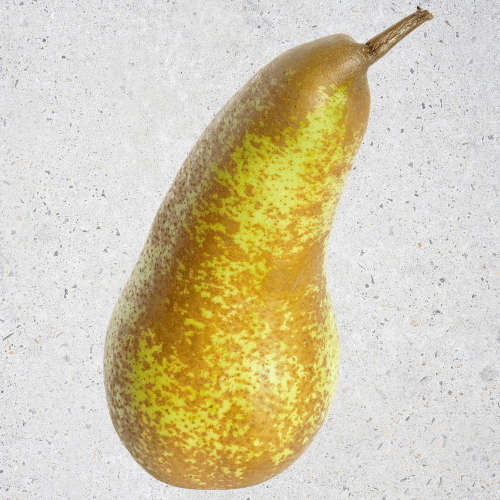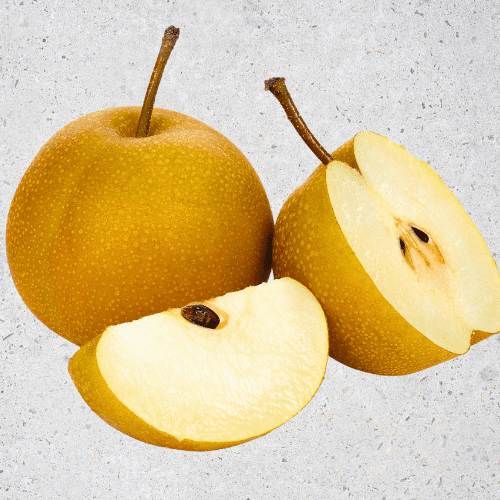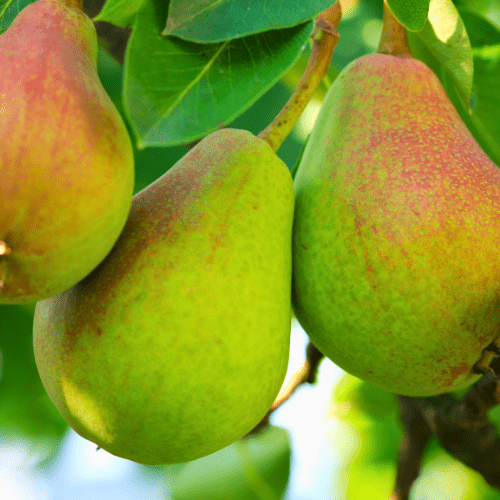Position
Plant your pear tree in full sun for the best fruit yield. They can tolerate some shade they will not fruit as much or grow as fast. They are easy to grow if you protect them from heavy wind and areas where frost lingers.
Size
Pear trees have more of a conical (narrow but tall) growth habit. At maturity, they reach up to 6 metres tall and 4 metres wide.
Soil Type
This tree can tolerate most soils, but not heavy clay. A sandy loam soil is best as good drainage is important. Organic compost with soaked peat moss gives your pear tree a good start.
Watering
Newly planted pear trees need frequent watering to establish their root systems. Water them deeply once a week during their first growing season. Ensure the soil stays consistently moist but not waterlogged.
Established Trees: Once established, pear trees are less needy but still require regular watering, especially during dry periods. A mature pear tree generally needs about 1 inch of water per week from rainfall or supplemental irrigation.
Water deeply to encourage deep root growth. Shallow watering can lead to shallow roots, which makes the tree more susceptible to drought. Apply water slowly to allow it to penetrate the soil thoroughly. Drip irrigation systems deliver water directly to the root zone, minimizing water wastage and reducing the risk of fungal diseases that can occur with overhead watering.
Mulch
Apply organic mulch to your pear tree all year round.
Use from 2 to 5 centimetres of pine bark mulch to protect the roots from UV damage and drying out. It retains moisture, and maintains an optimal pH. Do not let the mulch touch the plant stem, as it may cause infection or rot.
Watering
Newly planted pear trees need frequent watering to establish their root systems. Water them deeply once a week during their first growing season. Ensure the soil stays consistently moist but not waterlogged.
Established Trees: Once established, pear trees are less needy but still require regular watering, especially during dry periods. A mature pear tree generally needs about 1 inch of water per week from rainfall or supplemental irrigation.
Water deeply to encourage deep root growth. Shallow watering can lead to shallow roots, which makes the tree more susceptible to drought. Apply water slowly to allow it to penetrate the soil thoroughly. Drip irrigation systems deliver water directly to the root zone, minimizing water wastage and reducing the risk of fungal diseases that can occur with overhead watering.
The frequency of watering depends on the weather, soil type, and tree age. Sandy soils drain quickly and may require more frequent watering, while clay soils retain moisture longer.
Fertilising
Apply our slow-release all-plant fertiliser. Apply 1 teaspoon every 4-5 months. The roots will absorb what they need.
Alternatively, apply a balanced fertiliser (such as 10-10-10) in early spring before new growth begins. Thereafter fertilise annually in early spring.
Pruning
Cut your tree to about four healthy shoots every winter, and thin out excess and unruly spurs. This encourages fruit and flowers to grow.
Pests and Diseases
Pear trees are susceptible to various pests and diseases impacting their health and productivity.
Regularly inspect your pear trees for signs of pests and diseases.
Prune trees to improve air circulation and reduce the spread of diseases.
Remove and destroy infected plant debris to reduce disease spread.
Treat promptly or preferrably use preventative measures by spray with agricultural Neem Oil or Effective Microorganisms (EM Control)
Thinning Fruit
Thin fruit in early summer when they are small, to promote larger, healthier fruit and prevent branch breakage due to excessive weight.
Harvesting
Pears ripen from the inside out. So, once it looks and feels completely ripe on the outside, it’s likely to be mushy and overripe in the centre. This means that you should pick them when they are still quite firm to the touch.






